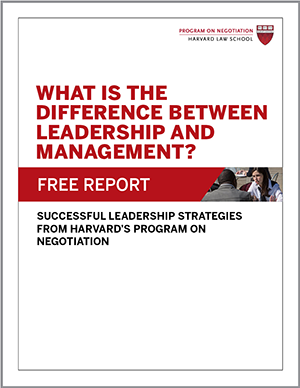
These days, directive leadership tends to be out of fashion, with many experts promoting a more egalitarian management style. Yet directive leadership has its time and place, according to research dating back decades.
Path-Goal Theory and Directive Leadership
The concept of directive leadership is rooted in an influential 1971 Administrative Science Quarterly article by Robert House, “A Path Goal Theory of Leader Effectiveness.” In it, House stresses the interdependence between leaders and followers, noting that leaders’ behavior is contingent on the satisfaction, motivation, and performance of their subordinates. In a 1996 revised version of the paper, House writes that the job of managers is to guide workers to choose the best paths to reach their own goals and those of the organization.
In a 1975 paper, House and Terence R. Mitchell present four different types of leadership styles:
- Directive leadership is a task-oriented style in which the leader takes an active role in setting clear objectives and ensuring employees follow through on them. This type of leadership style is most effective when employees face ambiguous demands that are intrinsically satisfying.
- Supportive leadership emphasizes the importance of respect, trust, and affiliation between leaders and team members. Leaders aim to be friendly, approachable, and responsive to employees’ struggles and concerns. This leadership style is particularly helpful when subordinates face tasks that are psychologically or physically taxing.
- Participative leadership is a democratic approach in which leaders intentionally involve subordinates in organizational decision making. Goals of participative leadership include enhancing employees’ sense of ownership of their work, improving overall decision making, and integrating workers’ personal goals with those of the organization.
- Achievement-oriented leadership is marked by setting challenging goals for subordinates and expecting them to perform at their best. This leadership style is often found in technical jobs, sales, engineering, and entrepreneurship.
Rather than advising leaders to choose one particular leadership style and stick with it, House expected that leaders would draw from different leadership styles based on the organizational context. Often, though, leaders gravitate toward the leadership style that best suits their personality—for better or worse. Someone who is impatient and authoritative by nature might lean toward directive leadership. And someone who is more nurturing and indecisive might favor participative leadership.
Directive Leadership: Who Thrives on It, and Why?
When might directive leadership, in particular, be a help or a hindrance in organizations? In their paper, House and Mitchell cite research suggesting that when task demands or organizational procedures, rules, and policies are unclear, “a leader behaving in a directive manner complements the tasks and the organization by providing the necessary guidance and psychological structure for subordinates.” By contrast, they write, “when task demands are clear to subordinates, leader directiveness is seen more as a hindrance.”
Along these lines, in a 2022 study of decision making in crisis-management teams, Corinne Post and colleagues found that participative leadership improved decision accuracy in unfamiliar emergencies, while directive leadership improved accuracy in familiar crises. In addition, the results showed that “directive leadership produces speedier decisions than participative leadership when the team is familiar with the crisis.”
In addition to the aspects of the situation, employee characteristics can shape which type of leadership style is most effective. Among lower-ranking subordinates at a manufacturing firm charged with routine, repetitive, and unambiguous tasks, those who were more closed-minded and dogmatic preferred a directive leadership style, according to research by Gary Dessler, while those who were more open-minded preferred a nondirective leadership style. By contrast, higher-ranked employees who performed nonroutine, ambiguous tasks tended to prefer directive leadership across the board.
The way in which directive leadership is used in a group also matters. In a 1997 study, R.S. Peterson found that directive leadership was highly effective when used to regulate the process by which groups made decisions, leading to high-quality group processes and outcomes. By contrast, “outcome directiveness,” or the degree to which a leader advocates their preferred solution, was far less effective. Thus, it may be wise for leaders to be more directive during the decision-making process without advocating for a favored outcome.
Directive Leadership vs. Participative Leadership
Directive leadership is often contrasted with participative leadership, as the two are often seen as polar-opposite leadership styles—the former more authoritarian and top-down, the other more collaborative and nonhierarchical. In a 2014 study by Clement Bell and colleagues, both participative leadership and directive leadership were found to have positive effects on organizational culture but that directive leadership made employees less adaptable. Along these lines, a 2018 study by Guiquan Li and colleagues found that directive leadership increased team efficiency but decreased team creativity, whereas participative leadership had the opposite effect.
In sum, directive leadership has both pros and cons, depending in part on the type of decisions being made, the outcomes desired, and the people involved. The research we’ve covered should help you determine when directive leadership is the best choice—and when a more participative leadership style would be preferred.
What have your experiences been with directive leadership?





